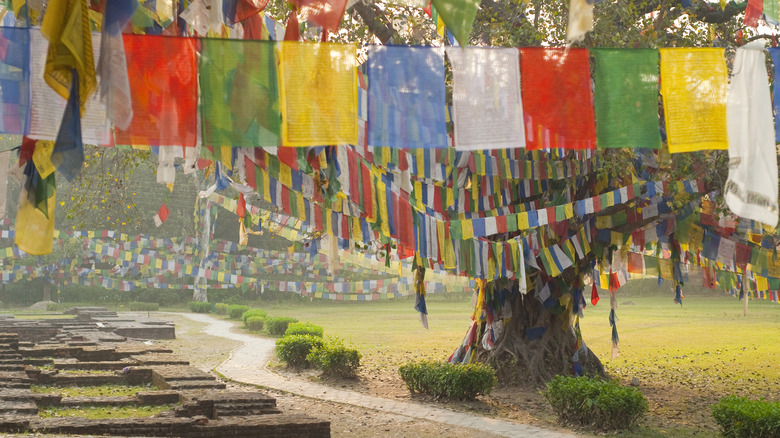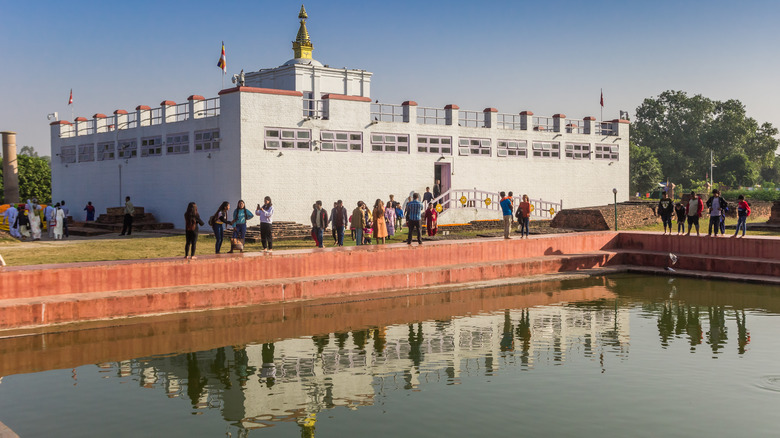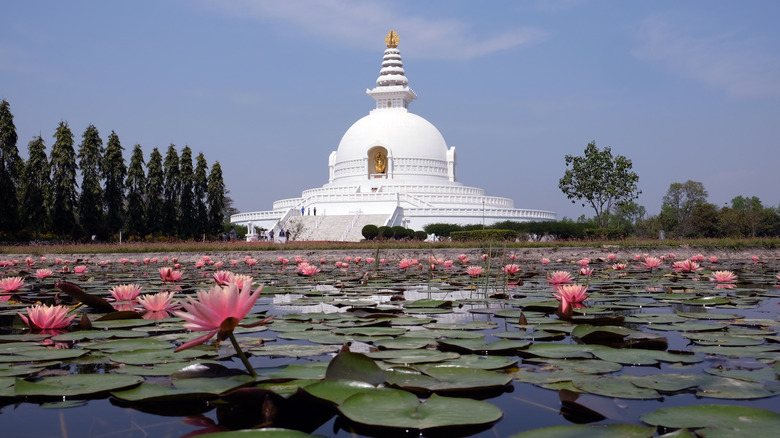'The Birthplace Of Buddha' Offers Glittering Temples And Meditation Retreats In The Mountains Of Nepal
There's something magical — or almost sacred — about a place where a legendary figure first set foot and walked, changing how we perceive the world for the better. One place is Lumbini. Nestled in southern Nepal, along the border with India, surrounded by verdant gardens and flowing rivers, Lumbini is said to be the location where the Buddha was born in 623 B.C. Today, Lumbini is a UNESCO World Heritage Site that welcomes visitors and pilgrims to follow in his footsteps, join meditation retreats, and visit temples for prayer and cultural exchange.
Among stupas and monasteries, the Lumbini area is divided into three main parts: The spiritual heartland called The Sacred Garden, where Buddha was born; the Monastic Zone; and the cultural hub, which includes the New Lumbini Village. And as you begin your journey toward enlightenment, you are welcomed by colorful prayer flags, each color indicating an element and carrying its own meaning. Red stands for fire and vitality, yellow for earth and balance, white for innocence and air, green for water and calm, while blue represents the sky and immensity.
Also located here is the India International Centre for Buddhist Culture and Heritage (IICBCH), whose construction started in August 2023. It's an eco-friendly, lotus-inspired structure that houses meditation and exhibition spaces. The hub will offer a safe place for intercultural dialogue and provide valuable information about the Buddha. According to the Lumbini Development Trust, the town attracted 1,172,304 visitors in 2024, placing it alongside the world's most visited city in Asia for its street life and temples.
Buddhist temples and meditation in Lumbini
A must-see in Lumbini's sacred garden is the Maya Devi Temple. Known as the Buddha's birthplace, the temple was built in 249 B.C. and rediscovered in 1849. Next to the temple stands the Ashoka Pillar, dating back to the 3rd century B.C., erected by Emperor Ashoka during his pilgrimage to Lumbini to mark the Awakened One's origin. As you wind your way through, you'll notice monks wrapped in saffron robes gathered in quiet devotion, embodying the Buddha's philosophy of freedom from earthly sins. Pal Thubten Shedrub Ling Monastery is also an important location in Lumbini, known to be the place where you can deepen your practice and reach liberation through the teachings of dharma, usually by presenting candles or floral tributes. You can also explore its stunning rooms, marveling at the shrine halls and the library.
Lumbini offers meditation centers that represent both the Mahayana and Theravada traditions of Buddhism. Panditarama Lumbini International Vipassana Meditation Center is one of the most popular, helping you disconnect from the external world and turn inward. The center focuses on a consistent meditation routine, requiring a minimum stay of 7 days. The European Buddhist Monastery, born from the Western desire to connect spiritually with the Buddha, serves as a retreat where you can find answers to your quest for existence and happiness. Among the most relevant monasteries are the Royal Thai Monastery (a must-see for its Thai design aesthetics) and Myanmar's Golden Temple, alongside others representing Europe, Asia, and North America. No formal dress code exists; however, it's considered respectful to familiarize yourself with the rules of etiquette before visiting a Buddhist temple.
What to see around Lumbini
Located in the Monastic Zone, the World Peace Pagoda is one of the world's largest stupas, built by Japanese Buddhists for $1 million. Its shiny white color symbolizes peace, and it is home to a golden Buddha statue. Go inside and climb the staircase for a panoramic view of Lumbini. Constructed during the 6th century, Ramagrama Stupa is the only place where you can find the Buddha's remains. Italian architect Stefano Boeri plans to make this stupa a center for meditation and serenity while preserving its historical meaning in accordance with Buddhist philosophy. In his project, two magnificent gardens and historic Bodhi trees will also encircle the center.
Given the region's vast size of 8,605 square miles, cycling is the best way to discover Lumbini. You can cycle around the area and leave your bike at the entrance. For a unique experience, hop on a boat along the canal up to the Eternal Flame at the garden's center. Established in 1986, this 24-hour flame was created to celebrate the universal year of peace and advocate for peace worldwide. Outside Lumbini's holy ground, visitors can socialize — or seek ancient wisdom — at relaxed coffee shops. Don't leave without souvenirs; pop into Bhaishiya, a renowned artisan shop that sells symbolic items like handcrafted statues and authentic Nepalese fabric.
Nepal is also known for its incredible hiking trails, including Everest Base Camp and the Annapurna Trek. If your first stop is Lumbini, the best way to reach it is from India or to fly to Nepal's Gautam Buddha International Airport, followed by a 30-minute taxi drive. Kathmandu is the primary gateway, and you can book a private transfer; however, despite the breathtaking views, the long, unpaved road can make the journey challenging.


